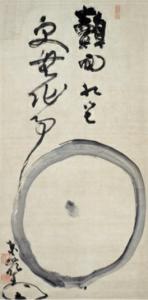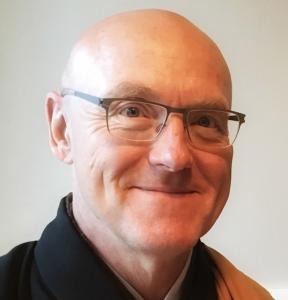
One of the hallmarks of Hakuin’s vivid style of Zen was his emphasis on the importance of practice post-kenshō, digging into the subtlety of many subsequent kōans. This work was seen – and is still seen in our Harada-Yasutani kōan-introspection tradition for which Hakuin was one of the founders – as essential refining of the initial insight, enabling one to function freely, and serve as a guide for others intent on awakening, actualizing the Four Great Vows.
It’s also one of the things that Hakuin was pumped about in terms of his contribution to the dharma world. For example, in The Complete Plum Blossoms in a Thicket of Thorn (CPB, “Gudō’s Lingering Radiance”), Hakuin reports how he helped an old priest named Zenkai to kenshō and then continue the work. Hakuin further tells us that Zenkai would bow down daily, and mournfully weep out praise like this (I hear this with Hakuin as the ventriloquist, and Zenkai, the puppet):
“I have recently been greatly puzzled as to why none of the fine Buddhist teachers of the past has spoken of the practice that comes after satori. I searched through the [many Zen records]…. But I never found any mention of this very important matter. How wonderful it is that my teacher [Hakuin] has devoted his life to making this great truth known, to teaching people that post-satori practice invariably gives rise to the Bodhi-mind and enables people to avoid the awful fate that otherwise awaits them in the evil paths. ”
However, one of Hakuin’s main students, Daikyū, left Hakuin’s temple, Shōin-ji, soon after his initial awakening, an awakening that was said to have “penetrated deeply to the Dharma source.” Perhaps rather than living with the reportedly overbearing Hakuin, Daikyū opted to travel around and looking for a beautiful, quiet spot to settle in and devote himself to his practice. In a letter preserved in CBP 191, Hakuin tells Daikyū that if he doesn’t return and continue kōan work, “… You will never acquire the ability to teach even a dunce of the poorer sort.”
Old Hakuin was a wild man, living with his emotions pouring out, apparently, not all the “Zen master” spiritual masquerade.
Hakuin’s letter to Daikyū begins on a seemingly friendly note, though, letting him know that all of Hakuin’s other senior priests are there with him at Shōin-ji and that “…Everyone is resolutely bent on refining and polishing their attainment. They endure the bitter cold and other privations without complaint, never slackening their efforts at all.”
From what I’ve seen, though, I’d say it isn’t at all uncommon for practitioners to slacken their efforts after kenshō. “Oh, there’s sesshin this weekend? I’d love to do it, but … it’s really the only time that I have to change the storm windows.”
In addition, ignorance has a wonderful way of reasserting itself after kenshō. Practitioners sometimes sail through a whole bunch of kōan in the wake of an opening, only to find themselves stuck on one of the kōans in the Miscellaneous Collection or on some tasteless thing like No Gate Gateway, Case 4: “Why has the Western Paradise Barbarian no beard?”
One tell-tale sign that we’re going off in stuckland is that we focus time and energy on how to present the koan to the teacher, rather than accepting the likely fact that there is more to see in this kōan, then focussing on being more intimate with the koan itself, attending to the subtle aspects, which usually lay waiting in our blind spots. Worry about the presentation is a way of focussing too much on the teacher rather than our own insight.
Hakuin, also in the letter to his errant student Daikyū, explains the process of post-kenshō training:
“Genuine [ancestors] of the secret depths, in order to be able to undertake the teaching of the true Dharma, enter the training hall, mingle with the [community], sit silently at the rear of the hall, work on koans they haven’t yet passed, engage in practice sessions with their comrades, and in this way gradually accumulate Dharma assets and mature into great Dharma vessels. ”
In our Harada-Yasutani kōan curriculum, after passing through the initial kōan and checking questions, the student sets out on a journey that may well take ten years or a lifetime, working through hundreds of subsequent kōans and checking questions, just in this spirit. Not only does everyone who undertakes the journey not reach the end, but everyone who reaches the end will not become a kōan teacher. There are many ways to manifest the dharma and not everyone is karmically suited to teach. Or better, some folks are karmically suited to manifest in other ways than to take on the yoke of teaching.
However, Hakuin, thirty-years Daikyū’s senior, seems to have identified Daikyū as a potential successor and teacher, so he tried all sorts of shenanigans to tug on his heart to bring him back to Shōin-ji. “You will have plenty of time later [after I die], to hide yourself in the boondocks and investigate the matter of your self, but only limited time remains to me in which to sit in these broken-down old chambers laughing and chatting with my monks. I just wait, counting the days and nights off on my fingers, until you return.”
Ah, to sit in Hakuin’s chambers, laughing and chatting – if only there holodeck were online!
It isn’t clear from the record whether Daikyū returned or not. The wonderful translator and annotator, Norman Waddell, seems to think that he didn’t. What is clear is that Daikyū did become a powerful teacher. Waddell reports that “…Hakuin describes attending a large lecture meeting that Daikyū conducted at the great Tōfuku-ji in Kyoto. According to the Annals of Tōfuku-ji, eight hundred and thirteen priests and monks, including Tōrei and other students of Hakuin, participated in the meeting. Through assemblies such as this, Daikyū introduced Hakuin-style Zen to the large Gozan monasteries in the capital.”
So the student went the wrong way and it seems to have all worked out.
Or did it?
Daikyū died in 1774, just six years after Hakuin, so it turned out that he didn’t have much time after Hakuin died to wallow in the boondocks. The continuing line of transmission coming to us flowed through another of Hakuin’s students, Gasan Jitō (1727–1797).
Dōshō Port began practicing Zen in 1977 and now co-teaches with his wife, Tetsugan Zummach Sensei, with the Vine of Obstacles: Online Support for Zen Training, an internet-based Zen community. Dōshō received dharma transmission from Dainin Katagiri Rōshi and inka shōmei from James Myōun Ford Rōshi in the Harada-Yasutani lineage. Dōshō’s translation and commentary on The Record of Empty Hall: One Hundred Classic Koans, is now available (Shambhala). He is also the author of Keep Me In Your Heart a While: The Haunting Zen of Dainin Katagiri. Click here to support the teaching practice of Tetsugan Sensei and Dōshō Rōshi.












